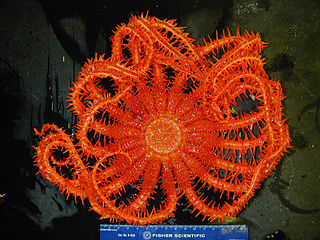
Starfish or sea stars are star-shaped echinoderms belonging to the class Asteroidea. Common usage frequently finds these names being also applied to ophiuroids, which are correctly referred to as brittle stars or basket stars. Starfish are also known as asteroids due to being in the class Asteroidea. About 1,900 species of starfish live on the seabed in all the world's oceans, from warm, tropical zones to frigid, polar regions. They are found from the intertidal zone down to abyssal depths, at 6,000 m (20,000 ft) below the surface.

The Valvatida are an order of starfish in the class Asteroidea, which contains 695 species in 172 genera in 17 families.

The Asterinidae are a large family of sea stars in the order Valvatida.

Patiriella is a genus of sea stars of the family Asterinidae. Many species formerly included in this genus have been transferred to other genera. They are commonly known as carpet sea stars.

Meridiastra calcar, formerly classified as Patiriella calcar, is a species of sea star in the family Asterinidae. It is endemic to Australia. It is commonly known as carpet sea star, cushion sea star, or eight-armed sea star.

Goniasteridae constitute the largest family of sea stars, included in the order Valvatida. They are mostly deep-dwelling species, but the family also include several colorful shallow tropical species.

Meridiastra mortenseni is a sea star of the family Asterinidae. It is endemic to New Zealand. Described as Patiriella mortenseni in 2002, it is named after T. Mortensen, who recorded it as distinct from Patiriella regularis, the New Zealand common cushion star, in 1925. According to genetic evidence, P. mortenseni was moved from the Patiriella genus to Meridiastra in 2004.

Asterina is a genus of asteroideans in the family Asterinidae.

The Brisingids are deep-sea-dwelling starfish in the order Brisingida.

Callopatiria is a genus of starfish of the family Asterinidae. The genus is found in shallow waters off South Africa, down to a depth of about 82 m (269 ft).

Cryptasterina pentagona is a species of starfish in the family Asterinidae. It is found in shallow waters in north eastern Australia. Its life cycle includes the release of large-yolked eggs and the development of planktonic larvae which is in contrast to the very similar Cryptasterina hystera which is viviparous. The two appear to have diverged from a common ancestral line only a few thousand years ago.

Cryptasterina hystera is a species of starfish. It is found in a limited region of the coast of Australia and is very similar in appearance to Cryptasterina pentagona. The two appear to have diverged from a common ancestral line a few thousand years ago.

Nepanthia is a genus of starfish of the family Asterinidae. Members of the genus have four to seven rays and are found in the eastern Pacific Ocean, ranging from Burma and Indonesia to Australia.
Paranepanthia is a genus of starfish of the family Asterinidae. Members of the genus have five rays and are found in the waters around Australia, Indonesia and Antarctic New Zealand.

Aquilonastra chantalae is a species of starfish from the family Asterinidae. Asterinid sea stars are typically quite small with an often pentagonal-shaped body, though there are exceptions. They are dorsally flattened and have short arms. The body's thin periphery is built up by very small marginal plates. One distinct characteristic of those in this family is the presence of an aboral face shaped by crescent-like plates.

Aquilonastra is a genus of small sea stars within the family Asterinidae. It has over 20 described species.

Aquilonastra burtoni is a species of small sea star from the family Asterinidae from the Red Sea which has colonised the eastern Mediterranean by Lessepsian migration through the Suez Canal, although the Mediterranean populations are clonal reproducing through fissiparous asexual reproduction. It was originally described in 1840 by the English zoologist and philatelist John Edward Gray.

Parvulastra is a genus of starfish belonging to the family Asterinidae. The species of this genus are found in Southern Hemisphere.

Cryptasterina is a genus of starfish belonging to the family Asterinidae. They occur in the Indian and Western Pacific Oceans in the littoral and shallow sublittoral zone.

Meridiastra is a genus of star fish in the family Asterinidae. The genus is found in the Indian and Pacific Oceans, with most records from the waters around Australia. They occur in shallow waters down to a depth of about 59 m (194 ft). Meridiastra are morphologically similar to the Atlantic genus Asterina. They are also phylogenetically close and possibly sister genera.





















